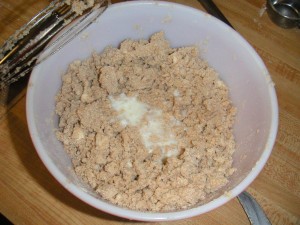by Catherine Haug, May 23, 2011
Now that you are learning to use sourdough, a natural leaven for baked goodies, are you wondering how to get the benefits of the fermented grain without the leavening for things like pie crust? If so, the answer is yes, you can, by using yogurt or whey as your starter (lemon juice also works, for those who cannot do dairy).
For a regular pie crust, use a mix of water and yogurt. For savory pies & tarts, such as Pasties, Lebanese Spinach Tarts and Mincemeat Pie, I like to use all yogurt (no water), for a slightly sour flavor that works well with the savory flavor of the filling.
I’d planned to make a crust for a rhubarb pie, so I thought I’d do a photo essay on how to make the fermented crust, including a link to my Rhubarb Custard Pie Filling recipe (pdf file prints on 3 x 5 index card). For a printable pdf version of this photo essay, see ‘Sourdough Pie Crust’.
Read on for more.
How To Make a Fermented Pie Crust
You can easily adapt any pie crust recipe in your collection, or you can use mine. This method works for a rolled crust and also for a crumb crust.
For a printable pdf version of this photo essay, see ‘Sourdough Pie Crust’.
Ingredients
Mine is to be a 10″ pie with a lattice crust on top (not quite as much dough as a 2-crust pie). Here’s all the ingredients:
- 2 cups flour
- 1 tsp unrefined sea salt
- 10 1/2 Tbsp butter (4 Tbsp melted, 6 1/2 Tbsp cold)
- 1 Tbsp yogurt (plain, unsweetened) or liquid whey, or lemon juice
- 1 – 3 Tbsp cold water
I’m avoiding wheat, so I used the following mix of whole grain and white flours (and of course it’s best if you use fresh ground flour; see The Importance of Grinding Your Own Flour):
- 1 cup whole vita spelt flour
- 1/4 cup whole oat flour
- 1/4 cup whole barley flour
- 1/2 cup unbleached white spelt flour
to which I added 1 tsp unrefined sea salt, then sifted into a bowl, and made a shallow well in the flour.
Cutting-in the butter
Pour melted butter into the well:
Then cut-in the melted butter to a light crumb:
Add cold butter in 1 Tbsp slices:
Cut-in the cold butter:
Nice oatmeal-like texture after cutting in butter:
Measure 1 Tbsp plain yogurt into a cup and add 1 -2 Tbsp cold water. If you use spelt in your flour mix, start with 1 Tbsp water, because it doesn’t require as much moisture as other members of the grain family.
Make another shallow well in the crumbs.
Cutting-in the yogurt starter
Stir the yogurt & water to blend, then add to the well:
Cut-in, adding more water if dough is too dry. Do not over-mix. I added another 1/2 Tbsp water for my mostly-spelt crust. Each time you make the crust, the amount of moisture needed will be different, depending on the humidity and air pressure.
Form dough into a ball
Using your hands, form the dough into a ball with your hands. If it won’t form into a ball easily, it needs more moisture (or more fat).
Wrap ball in waxed paper (I’m avoiding plastics so don’t use plastic wrap). This is to keep the surface from drying out during the overnight rest. Press the waxed paper against the dough as much as possible.
Rest for overnight fermentation
Cover with a cloth to keep out the light (you get better fermentation in the darkness, by simulating conditions when a seed germinates in the soil):
Let rest overnight, minimum 12 hours. Mine usually rests 18 – 24 hours.
Rolling out crust and filling the pie
In the morning, remove cloth and waxed paper. Since I’m doing a bottom crust and lattice top, I divide my dough into one larger and one smaller ball. You can then chill the dough if you wish, but I usually roll it out in the early morning before the room is really warm.
Roll out, or, if making crumb crust, press with fingertips into baking pan. For this pie, I rolled the crust and lattice strips:
Fill and bake the pie
Follow your recipe to fill and bake the pie. (My Rhubarb Custard Pie Filling recipe uses stevia as the sweetener, but I include instructions on substitution if you want to use sugar. Prints on 3 x 5 index card)
Here’s my rhubarb custard pie ready to bake (those yellow bits are butter). The second pan has pie crust cookies from leftover pastry (sprinkled with cinnamon sugar).
And the finished pie, cooling on rack. The crust got a bit dark because I had to take a phone call….
And here’s a pear tart (from last fall) baked in a fermented crumb crust pressed into a quiche pan:
If you want the pear tart recipe, you’ll have to email me.
For a printable pdf version of this photo essay, see ‘Sourdough Pie Crust’.















Fun-fun-fun,,,,,,,keep us posted on the results
I forgot to post the results. The pie is delicious, and this particular batch of crust is the best I’ve made yet. Guess I should take photos of all my cooking to improve the final product…
The pie is all eaten now; sorry none left to share.
Cat
” just read though your rhubarb pie piece: “can’t wait ’til spring: ‘ have my own patch of rhubarb! Alas, I’ve already used up all the frozen.
I live about 1800 miles away (so, no, I’ll probably not attend meetings). But, I do enjoy your web site. It is a testament to your hard work.
I read Dr. Mercola, also.
Doug